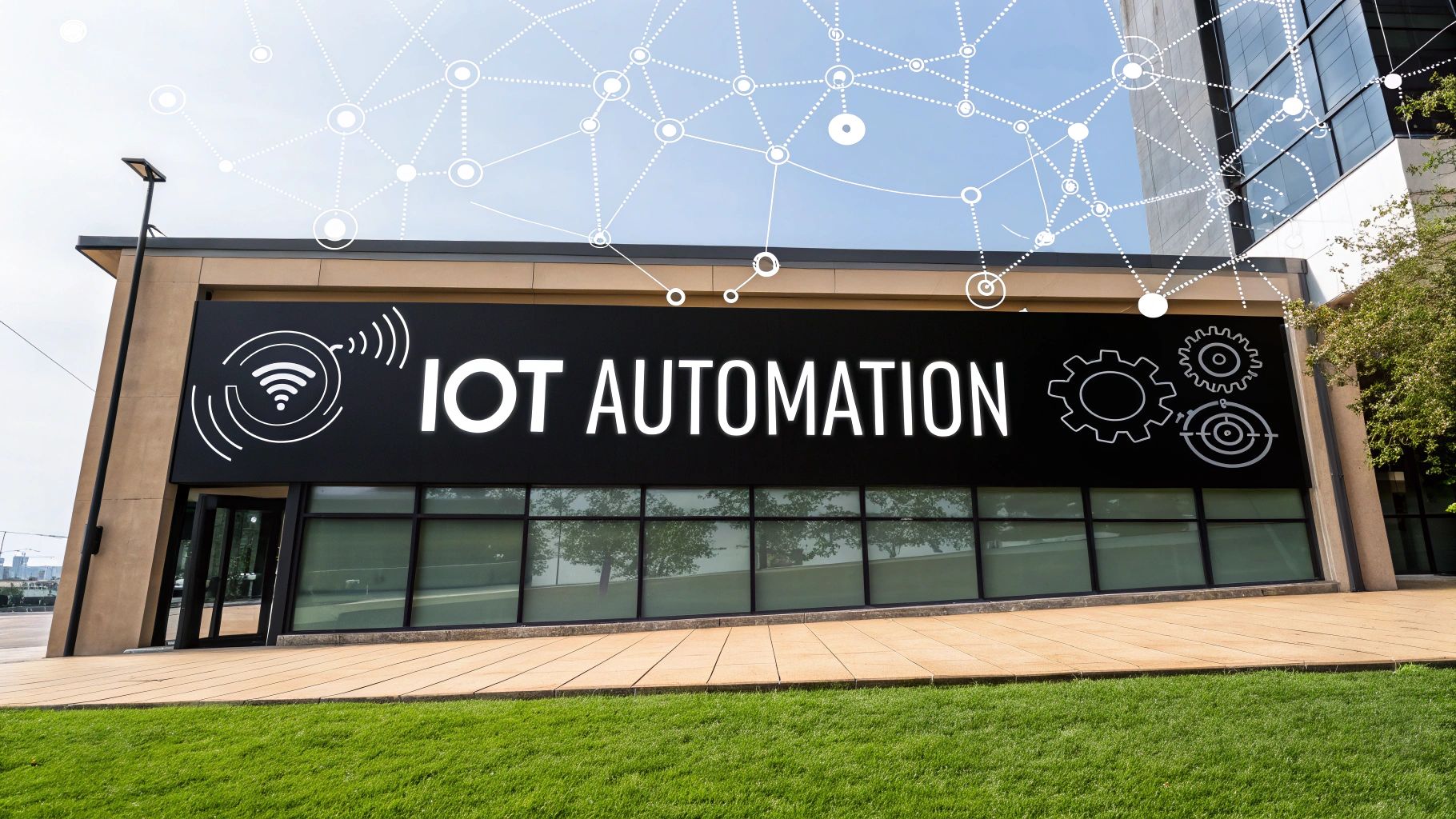Think of all the systems in your building—the heating, the air conditioning, the lights, the security cameras. In a typical setup, they all work independently. They’re like a team of skilled workers who never talk to each other. Internet of things building automation changes all that. It connects them into a single, smart network where every component communicates, creating a building that works together as a cohesive whole.
What Is IoT Building Automation Really?
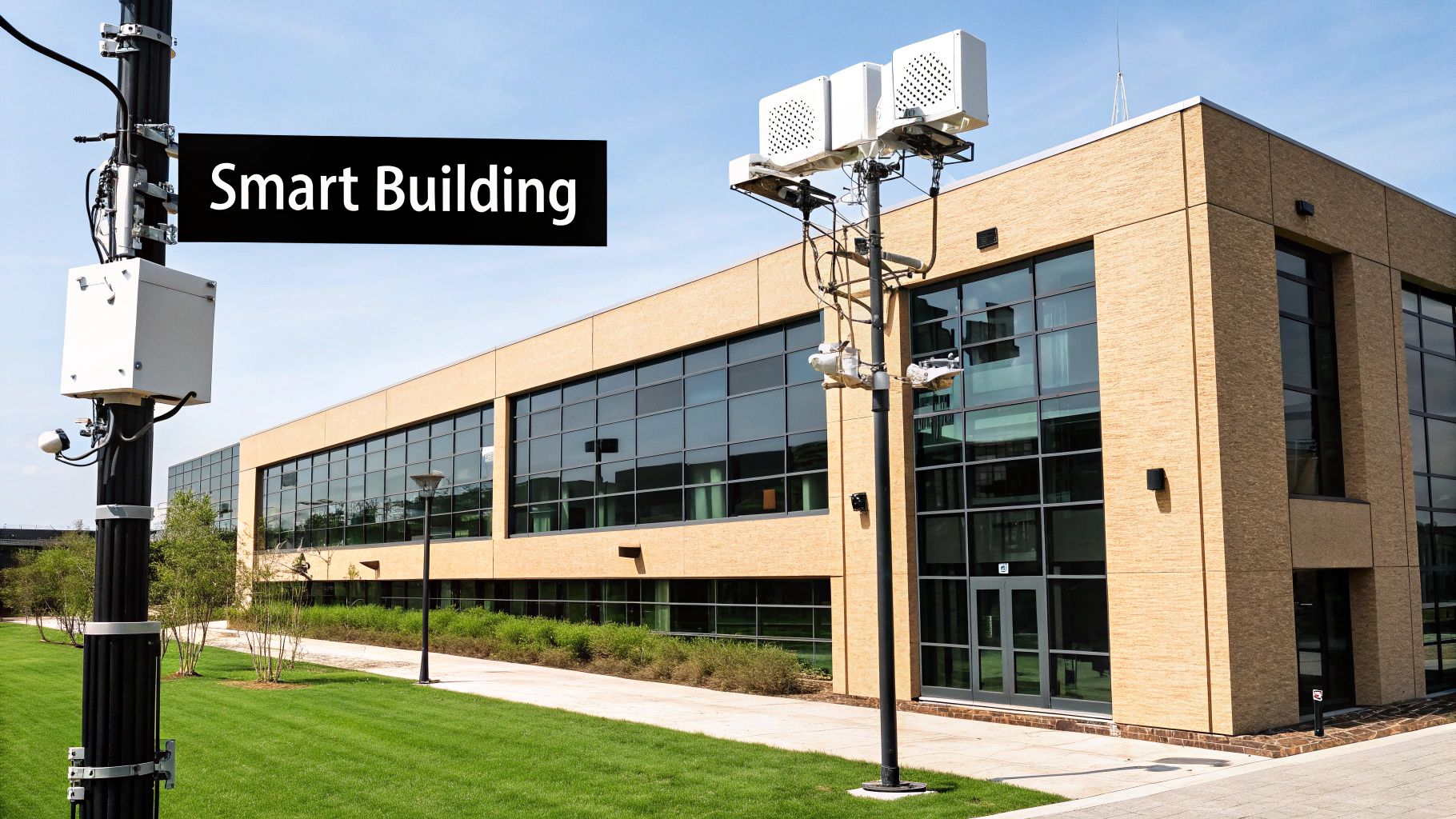
It’s about giving your building a central nervous system. Instead of being stuck with rigid schedules and manual tweaks, an IoT-enabled building uses a web of sensors and connected devices—from thermostats to door locks—to understand what’s happening in real time. They all feed information back to a central hub, allowing the building to think and react on its own.
The result is an environment that adapts dynamically. A conference room can automatically dim the lights and lower the temperature when it fills up with people. The security system can tell the difference between a scheduled nighttime cleaning crew and a potential intruder, sending alerts only when necessary.
From Reactive Fixes to Proactive Control
This is a fundamental shift in how buildings are managed. Traditionally, you only know something is wrong when it breaks. The air conditioning fails during a heatwave, or a light burns out in a critical area. With IoT automation, the building tells you about problems before they happen. Sensors can pick up on a subtle vibration in an HVAC motor, signaling it needs a check-up long before it fails completely.
This connected approach isn’t just about convenience; it’s about turning a static structure into a responsive, data-generating asset. The building learns patterns, anticipates needs, and optimizes itself for maximum efficiency and occupant comfort.
It’s no surprise that this approach is catching on. The Building Automation System (BAS) market is on track to grow from USD 105.32 billion to an estimated USD 205.55 billion by 2030. That’s a powerful compound annual growth rate of roughly 11.78%, driven by businesses eager to unlock these benefits.
To see this shift in action, let’s compare how things get done in a traditional building versus one with an integrated IoT system.
From Traditional Buildings to Smart Ecosystems
The table below shows the practical difference in day-to-day management when moving from isolated, manual systems to a fully connected and automated environment.
| Building Function | Traditional Management | IoT Automated Management |
|---|---|---|
| HVAC Control | Fixed schedules; manual adjustments based on complaints. | Temperature and airflow adjust based on real-time occupancy and weather data. |
| Lighting | On/off based on a timer or manual switches. | Lights dim or brighten based on natural light and motion detection. |
| Security | Guards watch cameras; alarms triggered by simple motion. | AI differentiates between threats and normal activity; alerts are specific and automated. |
| Maintenance | Reactive repairs after a system fails. | Predictive maintenance alerts are sent when sensors detect signs of wear. |
| Space Utilization | Guesswork based on observation or periodic headcounts. | Heatmaps and sensors provide precise data on how and when spaces are used. |
The move to IoT isn’t just an upgrade—it’s a complete re-imagining of what a building can do.
The Foundation of a Smarter Space
At its core, IoT automation is a simple, continuous loop: gather data, analyze it, and act on it. This cycle is what transforms a building from a passive container into an active partner in your operations. The impacts are profound:
- Operational Efficiency: When routine tasks like adjusting thermostats and light schedules are automated, your facilities team can focus on more strategic work instead of putting out fires.
- Enhanced Occupant Experience: A building that caters to its occupants’ needs creates a more comfortable and productive atmosphere. For a deeper look, you can read our guide on enhancing user experience with IoT.
- Data-Driven Decisions: Instead of guessing, you get hard data on everything from energy consumption to which meeting rooms are most popular, empowering you to make smarter, cost-saving choices.
The 4 Layers of a Smart Building Ecosystem
To really get what makes internet of things building automation tick, you have to look under the hood. It isn’t just one magic box; it’s a complete ecosystem where different technologies work together in layers. The best way to think about it is like a four-story building, where each floor relies on the one below it to turn simple data into smart, automated actions.
This layered structure creates a seamless flow of information. A tiny temperature reading from a sensor on the first floor can trigger a complex, building-wide decision on the top floor that saves thousands in energy costs. It’s this logical progression that makes the whole system so powerful.
The infographic below shows how the main goals of IoT in buildings—like cutting energy waste, predicting equipment failures, and keeping people comfortable—are all direct results of this smart, layered design.
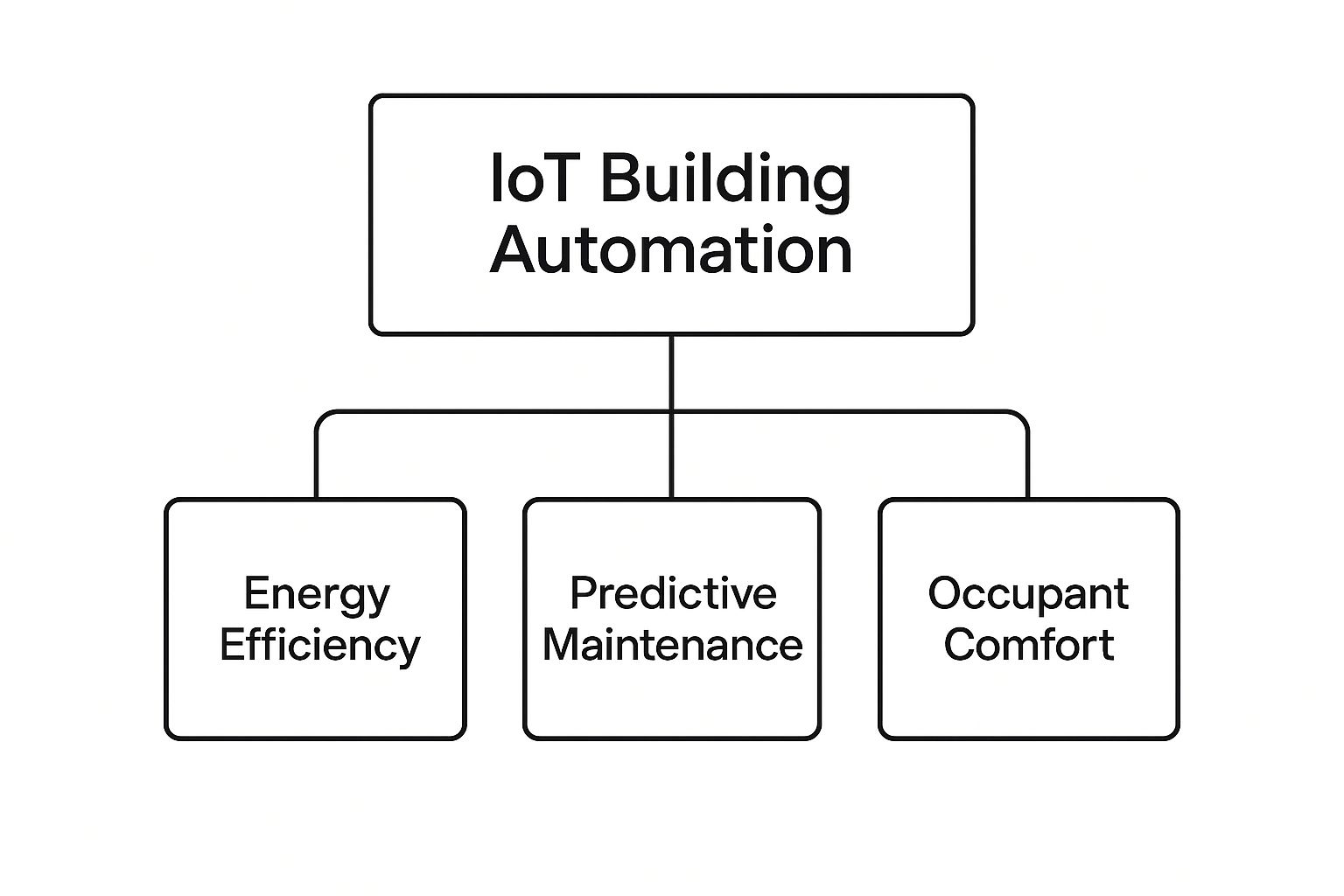
As you can see, these aren’t just standalone perks. They are the natural outcome of a well-planned automation strategy.
Layer 1: The Sensor and Device Foundation
This is the ground floor of the whole operation. It’s where the physical building connects to the digital world. Think of this layer as the building’s senses—its eyes, ears, and hands, all responsible for either collecting raw information or carrying out a command.
- Sensors: These are the data gatherers. They measure everything from the temperature in an office and the number of people in a conference room to the amount of daylight coming through a window or the subtle vibrations of an aging HVAC unit.
- Actuators and Devices: These are the doers. They get instructions from the system and make a physical change. A smart thermostat adjusting the AC, motorized blinds rolling down, or a smart lock securing an entrance are all perfect examples.
Layer 2: The Connectivity Network
The second layer is the building’s central nervous system. This network is what carries all the data from the sensors up to the system’s brain and sends commands back down to the devices. Without a solid network, the whole system grinds to a halt.
You’ll often see a mix of technologies here, including:
- Wi-Fi: Great for devices that need a lot of bandwidth and are located in areas with strong, existing wireless coverage.
- LoRaWAN: This stands for Long Range Wide Area Network, and it’s ideal for connecting low-power sensors scattered across a huge area, like a corporate campus or a high-rise.
- Wired Connections: For mission-critical equipment like servers or security cameras, nothing beats the reliability and security of a good old-fashioned Ethernet cable.
The real trick is to use the right combination of these technologies. You need to make sure every single device, whether it’s in the basement boiler room or on the roof, has a clear and constant connection to the central system.
Layer 3: The Central Platform
Welcome to the brains of the operation. The central platform, which is almost always cloud-based, is where all the data from every sensor gets sent. Here, it’s collected, crunched, and analyzed. This is where the “smart” in smart building truly comes to life.
Powerful software uses algorithms and machine learning to spot trends, make predictions, and uncover insights. For example, the platform could cross-reference occupancy patterns with the local weather forecast to create an incredibly efficient heating and cooling schedule. Or, it might flag an unusual spike in energy use from a specific piece of equipment and automatically generate a maintenance ticket.
Layer 4: The User Interface
The final layer is the control panel. The user interface (UI) is where facility managers and building operators can see and manage everything. It’s usually a dashboard you can access on a computer, tablet, or phone.
This interface turns mountains of raw data into easy-to-understand charts, heatmaps, and alerts. It’s where your team can set rules, adjust schedules, and respond to issues. Essentially, this is where data becomes actionable intelligence, giving your team the tools to run the building with incredible precision and foresight.
Unlocking Real-World Business Benefits
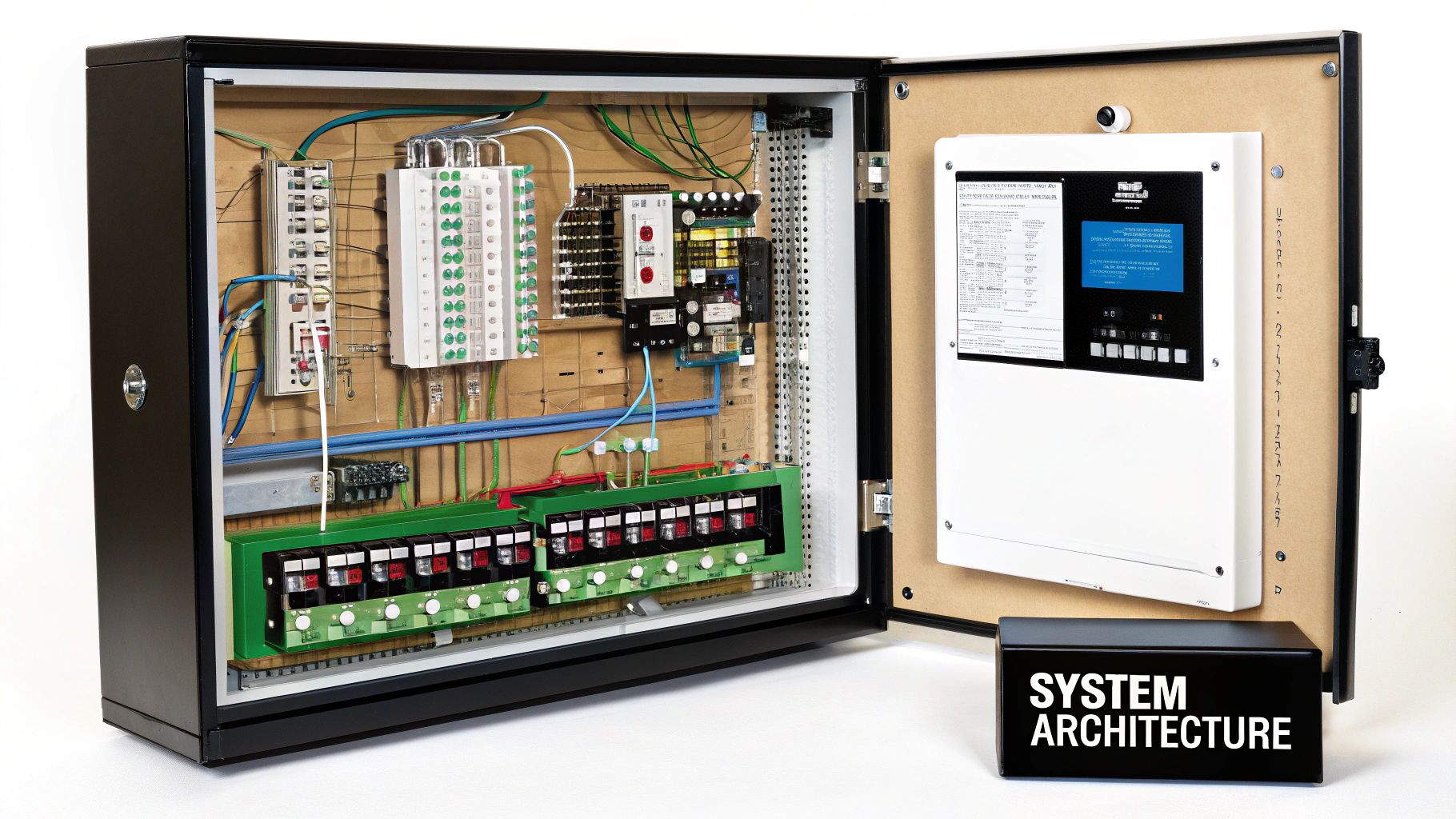
The theory behind internet of things building automation is great, but let’s get down to what really matters: what does it do for your bottom line? This isn’t just about adding shiny new tech to your property. It’s about generating tangible, measurable returns that ripple across your entire operation, from cutting utility costs to making your spaces more valuable and desirable.
This isn’t just a niche trend, either. The global smart buildings market is expected to skyrocket, growing by USD 76.8 billion by 2029. With a compound annual growth rate of roughly 11.3%, it’s clear that businesses are seeing the value and investing heavily in automation to boost their performance. If you’re interested in the market drivers, the full Technavio report offers a deeper dive.
So, how does this translate into practical benefits? Let’s break down the four key ways this technology delivers real value.
Dramatically Reduce Energy Consumption
For most commercial properties, energy is one of the biggest line items on the expense sheet. IoT building automation attacks this cost directly, shifting from rigid, outdated schedules to a truly intelligent and responsive system.
Think about it. Instead of blasting the HVAC in an empty wing of the building, occupancy sensors can tell the system to dial it back. Smart lighting can automatically dim or brighten based on how much natural daylight is available, saving a surprising amount of electricity without anyone even noticing.
This is about more than just turning things on and off. It’s about total optimization. The system can even look at the weather forecast to pre-cool a building during off-peak hours when electricity rates are at their lowest.
Enable Proactive Predictive Maintenance
Nothing throws a budget off like an unexpected equipment failure. The downtime, the emergency repair costs—it all adds up. IoT sensors act as a round-the-clock health monitor for your building’s most critical systems, from the elevators to the boilers.
These sensors constantly track performance data like vibration, temperature, and power consumption. The moment they detect a small anomaly that points to a future breakdown, the system flags it and can even generate a maintenance ticket automatically. This means your team can fix small problems during scheduled downtime, long before they become catastrophic failures. The result? Fewer headaches, longer equipment lifespan, and a much more predictable maintenance budget. You can learn more in our guide on the ROI for properties upgrading with technology.
Elevate Occupant Experience and Safety
A building that feels comfortable, responsive, and secure is a place where people want to be. IoT automation is a game-changer for enhancing the day-to-day experience for tenants and employees.
- Personalized Comfort: People can use a simple app on their phone to adjust the lighting and temperature in their immediate area, which is a huge boost for satisfaction and productivity.
- Integrated Security: Imagine linking your access control to the building’s other systems. When the last person badges out for the day, the building can automatically switch into a secure, energy-saving mode.
- Improved Air Quality: Sensors can keep an eye on CO2 levels and other pollutants, automatically kicking up the ventilation to ensure the air inside is always fresh and healthy.
Optimize Space and Resource Utilization
Are you really sure how your building’s space is being used every day? Guessing leads to wasted resources, from cleaning empty rooms to paying for underutilized square footage. IoT gives you the hard data you need to stop guessing.
Occupancy sensors and heatmaps can show you exactly which conference rooms are always in demand and which parts of the office are consistently empty. This kind of insight is pure gold. It helps you make smarter decisions about redesigning floor plans, creating more efficient cleaning schedules, and even guiding your future leasing strategy. When you understand exactly how people move through and use your property, you can maximize the value of every single square foot.
IoT Automation in Action Across Industries
It’s one thing to talk about the theory behind internet of things building automation, but seeing it solve real-world problems is where it all clicks. The core idea—connecting sensors, crunching the data, and triggering actions—can be molded to fit just about any commercial space.
Let’s take a look at a few examples to move past the buzzwords and see how this technology tackles specific operational headaches and delivers some serious, bottom-line results.
The Smart Office Building
Picture a corporate office that actively works to make employees more productive while simultaneously slashing waste. To do this, occupancy sensors are installed everywhere—not just conference rooms, but also open-plan areas, quiet zones, and collaborative hubs.
- The Problem: The lights and HVAC system are running on a fixed schedule, wasting a ton of energy heating and illuminating empty floors after hours or on slow days. On top of that, employees are constantly distracted by rooms being too stuffy or too cold.
- The IoT Solution: Instead of guessing, the system uses real-time occupancy data. It directs heating and cooling only to the areas where people are actually working. Lights automatically dim down in unused zones and brighten when someone walks in, even adjusting based on the amount of sunlight coming through the windows.
- The Result: The company sees an immediate, noticeable drop in its utility bills. Even better, by keeping the environment consistently comfortable, employees are happier and can focus on their work. It’s a powerful example of how smart building features, much like the innovations in smart apartment technology, directly enhance the daily experience for everyone inside.
The Connected Retail Store
For any retailer, the holy grail is understanding how customers behave inside the store. IoT gives them a way to get incredibly detailed insights into shopper journeys, helping them create an experience that naturally boosts sales.
It starts with placing foot traffic sensors and smart cameras at entrances and along the main aisles. These aren’t just counting heads; they generate anonymized heatmaps that reveal which displays are grabbing the most attention and where foot traffic gets congested.
This completely changes how the store is managed. Gut feelings are replaced with hard data on exactly how customers flow through the space and what they engage with.
The system cross-references this traffic data with sales figures and employee schedules. A manager might get an alert to move a cashier to a suddenly busy checkout lane, or they can see that a big promotional display is being completely ignored. This allows them to optimize the store layout to guide shoppers more intuitively and schedule staff to match real-time demand, ensuring top-notch service and maximizing every sales opportunity.
The Intelligent Warehouse and Logistics Hub
In a warehouse, everything hinges on keeping operations running smoothly and protecting the inventory. Here, internet of things building automation is all about predictive maintenance and perfect environmental control.
Vibration and temperature sensors are attached to critical equipment like conveyor belts and automated sorting systems. Meanwhile, in storage zones holding sensitive goods, climate sensors keep a constant watch on temperature and humidity.
The system is smart enough to detect tiny changes in a machine’s vibration that signal a potential breakdown is coming, long before it actually fails. If the temperature in a cold storage unit drifts even slightly out of range, an instant alert is sent. This shift from reactive fixes to proactive monitoring prevents disastrous downtime and saves millions in inventory from being ruined, creating a far more resilient and self-sufficient operation.
How to Navigate a Successful Implementation
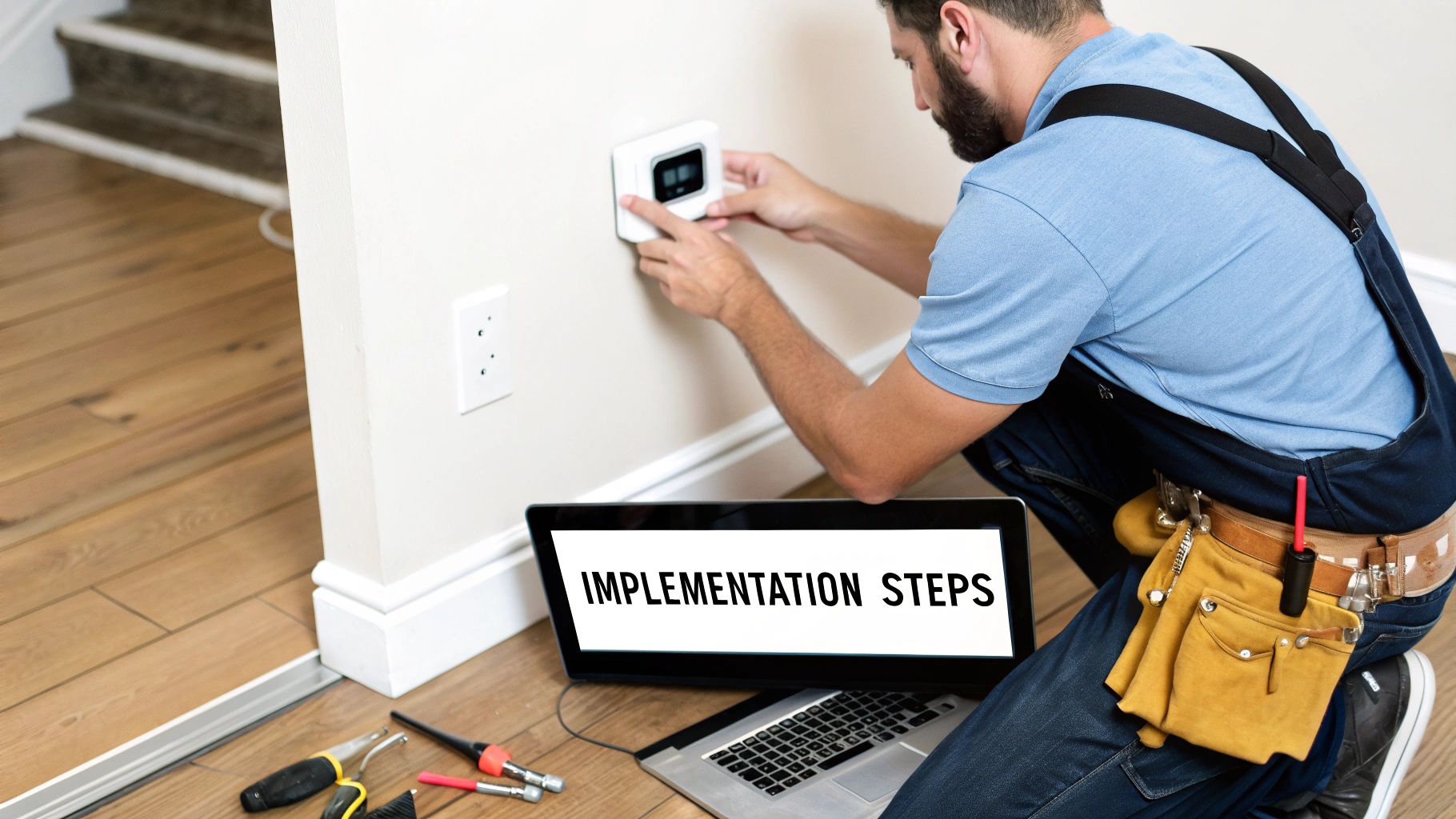
Getting into internet of things building automation is a big move, but having a clear roadmap can make or break the project. The real key to success is solid planning that tackles the common hurdles right from the start, like getting brand-new tech to play nice with older systems and locking down your cybersecurity.
A smart strategy helps you sidestep costly mistakes and makes sure your investment pays off for years to come. The first step is to respect the complexity. You’re not just plugging in a few new gadgets; you’re building a connected digital ecosystem where every piece needs to communicate and work together seamlessly.
Start Small and Prove the Concept
Instead of trying to transform the entire building at once, it’s much wiser to begin with a focused pilot project. This lets you test the technology in a real-world but controlled setting, iron out any wrinkles, and show a tangible return on investment before you go all-in.
A great pilot project could be something like:
- A Single Floor: Focus on automating the lighting and HVAC on just one level of your office.
- A Specific System: Add predictive maintenance sensors to your most essential—and expensive—HVAC equipment.
- One High-Traffic Area: Use occupancy sensors in the lobby or main conference rooms to dial in energy use and sync up cleaning schedules.
Nailing this first step builds momentum and gives you priceless data to inform a larger, building-wide rollout. It’s the perfect low-risk way to discover what truly works for your property.
The goal here is to get a small, undeniable win. When you can point to measurable energy savings or a clear jump in tenant comfort from the pilot, getting stakeholder buy-in for the next phase becomes a whole lot easier.
Prioritize Open Standards and Scalability
One of the biggest traps you can fall into is getting locked into a proprietary, single-vendor system. This move kills your flexibility and almost always leads to higher costs down the line when you want to upgrade or expand. The smarter approach is to seek out platforms built on open standards.
This ensures that devices and software from different manufacturers can actually talk to each other. It gives you the freedom to pick the absolute best sensor for one task and a different controller for another, without being tied to one brand’s catalog. This kind of mix-and-match adaptability is a huge reason the commercial Building IoT (BIoT) market is projected to grow from USD 64.1 billion to USD 101.0 billion by 2030. You can explore more about these market trends and how they’re shaping the industry.
Address Cybersecurity and Data Ownership from Day One
Every new connected device you add to your building is another potential door for a cyberattack. Security can’t be an afterthought—it has to be a foundational piece of your implementation plan from the very beginning.
You’ll also need clear policies on who owns the mountain of data your smart building will produce. Work closely with your technology provider to put strong security protocols in place:
- Network Segmentation: Keep your building automation network completely separate from your main corporate network. If one is compromised, the other stays safe.
- Strong Access Controls: Insist on multi-factor authentication to ensure only the right people can access the system and change critical settings.
- Regular Updates: Commit to keeping all software and device firmware patched. This is your first line of defense against known security holes.
By focusing on these three critical areas—piloting your concept, choosing open systems, and building in security from the ground up—you’ll lay a rock-solid foundation for a successful and valuable internet of things building automation project.
The Future Is Autonomous Buildings
The next big jump for internet of things building automation isn’t just about making things more automated—it’s about making them truly autonomous. Think of it this way: an automated building is like a skilled musician who plays sheet music perfectly. It executes pre-set rules without fail. An autonomous building, on the other hand, is like a jazz musician. It can improvise, learn, and make its own decisions based on the situation.
This leap is made possible by artificial intelligence (AI) and machine learning. Instead of just reacting to a command, an AI-powered system dives into historical data, checks real-time occupancy, and even looks at the weather forecast to make smart, proactive changes. It learns the unique rhythm of your building.
For instance, the system might figure out that one corner of the office always gets hotter on sunny afternoons. Rather than waiting for the thermostat to scream for help, it learns to start cooling that area a bit earlier. This keeps everyone comfortable, saves energy, and requires zero human input. It’s a building that actually thinks for itself.
From Optimization to Self-Management
This is where the idea of a digital twin gets really interesting. A digital twin is an exact virtual model of your physical building, constantly fed live data from its IoT sensors. It’s essentially a digital sandbox where the building’s AI can experiment without any real-world consequences.
The building’s AI can run thousands of “what-if” scenarios on the digital twin. It might test out different HVAC schedules or lighting setups to find the most efficient way to run things, all without a single person in the actual building noticing a thing.
Once the AI lands on a better strategy, it applies that winning formula to the physical building. This constant loop of learning, testing, and improving is what separates simple automation from true autonomy. It creates a facility that continuously sharpens its own performance.
This technology is the endgame for smart buildings: a fully autonomous partner that manages its own resources. It works 24/7 to hit your business goals, whether that’s meeting sustainability targets or slashing operational costs, creating a self-managing asset that only gets smarter with time.
Frequently Asked Questions
When people start looking into internet of things building automation, a few key questions always come up. It’s only natural to wonder about the price tag, how secure it all is, and whether it will even work with the equipment you already have. Let’s tackle those common concerns head-on.
What’s the Real Cost of an IoT Automation System?
This is a classic “it depends” situation, but for good reason. The cost really hinges on your building’s size, its age, and how big you want to go. A focused pilot project for HVAC and lighting on a single floor will have a very different price tag than a full-scale smart building conversion. The important thing to remember is that this is an investment designed to pay for itself through lower energy bills and smoother operations.
Plus, you don’t always have to face a massive upfront cost. Many providers now offer a Network-as-a-Service (NaaS) model. Think of it like a subscription—you get the technology, support, and upgrades for a predictable monthly fee, avoiding that huge initial capital outlay.
How Secure Is an IoT-Enabled Building, Really?
Security isn’t just a feature; it’s baked into the very design of a modern IoT system. It has to be. Since every connected device is a potential way in for an intruder, a robust, multi-layered security strategy is non-negotiable.
This typically includes:
- Network Segmentation: This is crucial. It means keeping your building’s operational network completely separate from your main corporate or tenant Wi-Fi.
- Strong Access Controls: Using tools like multi-factor authentication ensures that only the right people can access and adjust critical systems.
- Encryption: All the data flying between your sensors, devices, and the central platform is scrambled, making it unreadable to anyone who might intercept it.
When done right, a new IoT system can actually be more secure than older, standalone systems. You gain centralized monitoring and the ability to spot threats in real-time—something legacy setups just can’t offer.
Can IoT Work with My Old Equipment?
Absolutely. This is actually one of the biggest advantages of modern IoT platforms. You don’t have to start from scratch and rip out everything you own.
Specialized gateways and protocol converters act like translators, allowing brand-new smart sensors to talk to your trusty old HVAC units, lighting panels, and security hardware. This means you can upgrade your building in stages, enjoying new efficiencies without the headache and expense of a complete overhaul.
Ready to see how a smart, efficient, and secure environment can transform your property? Clouddle delivers complete managed technology solutions—from integrated security to high-performance Wi-Fi—all designed to boost your NOI and keep occupants happy. Discover how our flexible, zero-down-payment options can bring your building into the future.


